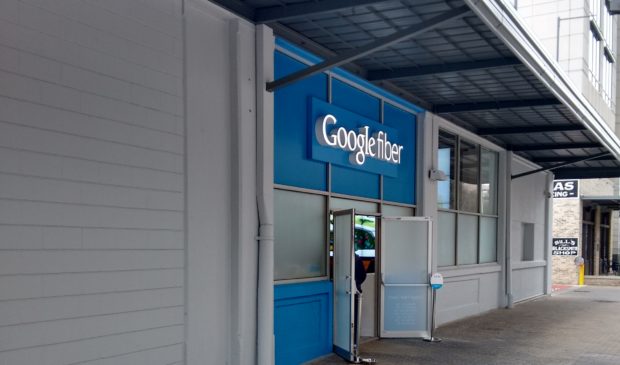Newsletter Signup
The Austin Monitor thanks its sponsors. Become one.
Most Popular Stories
- A once-banned type of building is back in favor – and the Planning Commission approves
- City facing a $33 million deficit for 2026
- SOS suing state agency over failure to provide information on MoPac expansion
- Staffing isn’t the only thing to blame for Austin’s slow 911 response times
- East Austin’s ‘wishbone’ bridge takes shape as concrete beams almost span Lady Bird Lake
-
Discover News By District

Austin’s Google Fiberhood smaller than promised
Friday, May 31, 2019 by Jessi Devenyns
In 2013, with much fanfare, Google announced the arrival of Fiber in Austin, with promises of providing free Google Fiber services to 102 city buildings. But the internet giant has succeeded so far in providing that service to only 28 sites.
When City Council passed a resolution in August 2013 to create the Community Connections program, the goal was to provide public and nonprofit sites that served the community with Google Fiber broadband internet for 10 years. That would mean that the service would extend until 2023.
However, with four years left in its agreement with the city and only 27 percent of the selected buildings enjoying a gigabit connection, the question is, will the rollout be completed?
Daniel Lucio, a manager with the Google Fiber & Community Connections program, told the Community Technology and Telecommunications Commission in September 2018 that due to geography, not all areas of Austin can be shallow-trenched to install the fiber cable. As a result, traditional construction and deployment is required in certain parts of the city, which can lead to delays.
Shallow trenching was Google’s answer to demands for fast rollout times of its fiber-optic cables to get service started. With this method, a groove is cut into the ground alongside a curb, cables are inlaid and the trench is filled in with a special epoxy. The process can be completed much more quickly and is far less disruptive than conventional methods of mounting cables on utility poles or digging deep into the ground to lay cable.
Lucio said, “We’ve made tremendous progress in increasing the speed of our construction in Austin.” Still, he noted that “the development of the network has taken a little longer than I thought (it) would.”
Shallow trenching has proved to be problematic in other cities. In a February blog post, Google announced it was pulling its Fiber services out of Louisville after launching in October 2017 due to issues with the shallow trenching method and the added expense.
Lucio said that Google Fiber has completed 500 miles of shallow trenching in Austin and that while slow, construction will continue well into 2019.
The internet provider has had eight months to continue construction since Lucio spoke with the commissioners. Despite that, according to the city’s data portal on the Community Connections program, there have not been any additional sites brought onto the Google Fiber network in that time.
Update: Lucio spoke with the Austin Monitor and explained that in the four years left in the Community Connections agreement with the city, Google Fiber is planning to connect to more sites. He said that he is “optimistic” about more connections coming online and emphasized that although the construction is slower than expected, it is still ongoing. A “variety of issues” including permitting and difficulties with micro-trenching in the rights of way has led to delays. He emphasized that even though the agreement with the city was signed in 2013, construction for Fiber did not begin until December 2014.
The Community Connections agreement he confirmed, is for “10 years of service from the date that the agreement was signed by the city.” As for extending the program past 2023, he said that the discussions with the city were preliminary.
John Speirs, with Austin’s Telecommunications and Regulatory Affairs Office, told the Austin Monitor that the city is aware of the large number of sites waiting to receive a Google Fiber connection. “There is definitely acknowledgment on our part that there need to be some negotiations … to ensure that this connection is offered to organizations even if they don’t get Fiber by 2023,” he said.
While Speirs said there are currently no answers on how an extended contract might look, he said the city should consider ways to continue the service. The Telecommunications and Regulatory Affairs Office is currently evaluating the types of internet service its facilities are using to better understand how Fiber fits into the equation.
In addition to Google Fiber service through the Community Connections program, there is the city of Austin enterprise internet, bandwidth from the University of Texas and paid service from Spectrum. “(Google Fiber) helps us because it eases the burden on what is very expensive internet. The city still has to pay the bill to access the internet,” explained Speirs.
As for the facilities that already have a Fiber connection, Speirs noted it is the “backbone” of those facilities’ internet service and he explained that beyond 2023, the city will need to budget to continue Fiber connections around the city – at least those that are already in place.
Photo by John Cummings [CC BY-SA 4.0], via Wikimedia Commons.
The Austin Monitor’s work is made possible by donations from the community. Though our reporting covers donors from time to time, we are careful to keep business and editorial efforts separate while maintaining transparency. A complete list of donors is available here, and our code of ethics is explained here.
You're a community leader
And we’re honored you look to us for serious, in-depth news. You know a strong community needs local and dedicated watchdog reporting. We’re here for you and that won’t change. Now will you take the powerful next step and support our nonprofit news organization?





